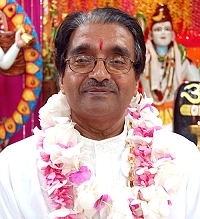From a discourse with Paramacharya of SWAHA, Pt. Hardeo Persad
Among the various pathways that lead to spiritual enlightenment, one such route is Ashtaang Yoga, which consists of holistic human development. Comprising the eight limbs of yoga, this path was enunciated by Maahaa Shakti to Shri Himalayaji in response to his request about the preparations necessary to welcome Devi into one’s life. This pronouncement of the Divine Mother constitutes Devi Gita, found in the scriptural text, Shri Devi Bhagavatam. The eight-fold pathway includes the following principles and practices: Yam, Niyam, Aasan, Pranayama, Pratyahaara, Dhaaranaa, Dhyaan and Samaadhi.
A brief explanation of each limb is provided as follows:
YAM: The ten forms of self-restraint are:
- Ahimsaa: non-aggression, causing no harm to others
- Satya: truthfulness
- Asteya: non-covetousness
- Brahmacharya: sacred study, maintenance of purity of mind and body, continence
- Dayaa: compassion
- Arjavam: straightforwardness, sincerity, honesty, purification of knowledge
- Kshamaa: forgiveness
- Dhriti: constancy, firmness
- Mitaahaara: control of diet
- Soucham: maintenance of internal and external cleanliness
NIYAM: The ten forms of positive virtues are:
- Tapasya: austerities
- Santosh: contentment
- Asteya: relentless pursuit of self-realisation
- Daanam: providing service, charity to others without expectation of fruits
- Devasya poojanam: worship of God
- Siddhaanta-sravanam: listening to Scriptures with unwavering attention
- Hrih: modesty
- Mati: self study; heightening state of self-awareness
- Jap: constant repetition of mantras, recitation of God’s names
- Homa: offerings into the sacred fire.
AASAN: posture
These involve synchronising breathing with a progressive and continuous series of yogic postures. The result is improved circulation, flexibility, stamina, a light and strong body, and a calm mind. Some major postures that are recommended are: Padmaasan (lotus posture), Swastikaasan (auspicious posture), Bhadraasan (gracious posture), Vajraasan (thunderbolt posture) and Veeraasan (warrior posture).
PRANAYAMA: breath control
In each individual there are three channels of bio-energy, namely, Ida Nadi, Pingala Nadi and Sushumna Nadi. Breath is inhaled through the Ida, retained at the Sushumna and exhaled via the Pingala Nadi. According to the principal laws of breathing it is recommended that one should follow the 1-4-2 process of purak-kumbhak-rechak or inhalation-retention-exhalation. This implies that one should inhale for one count (or multiples thereof), retain for four and exhale for two counts. Pranayama can also be performed with the recitation of mantras.
PRATYAAHAARA: the process of withdrawing the senses of perception and focusing on the object of concentration.
DHAARANA: deep contemplation with equilibrium of mind
DHYAAN: maintaining unity of individual soul and super soul through meditation
SAMAADHI: perfection of union where the individual soul is merged with the Super soul.
In order to bring Devi into one’s life and attain enlightenment, the aspirant needs to prepare oneself spiritually by following this pathway of Ashtaang Yoga as explained by Maha Shakti Herself. Such a saadhana (spiritual practice) augurs well for the practitioner to evolve towards spiritual harmony and helps to make one a fitting host to welcome and receive the Divine Mother. The period of Navratri is a most auspicious time to commence on this route to inner freedom.



